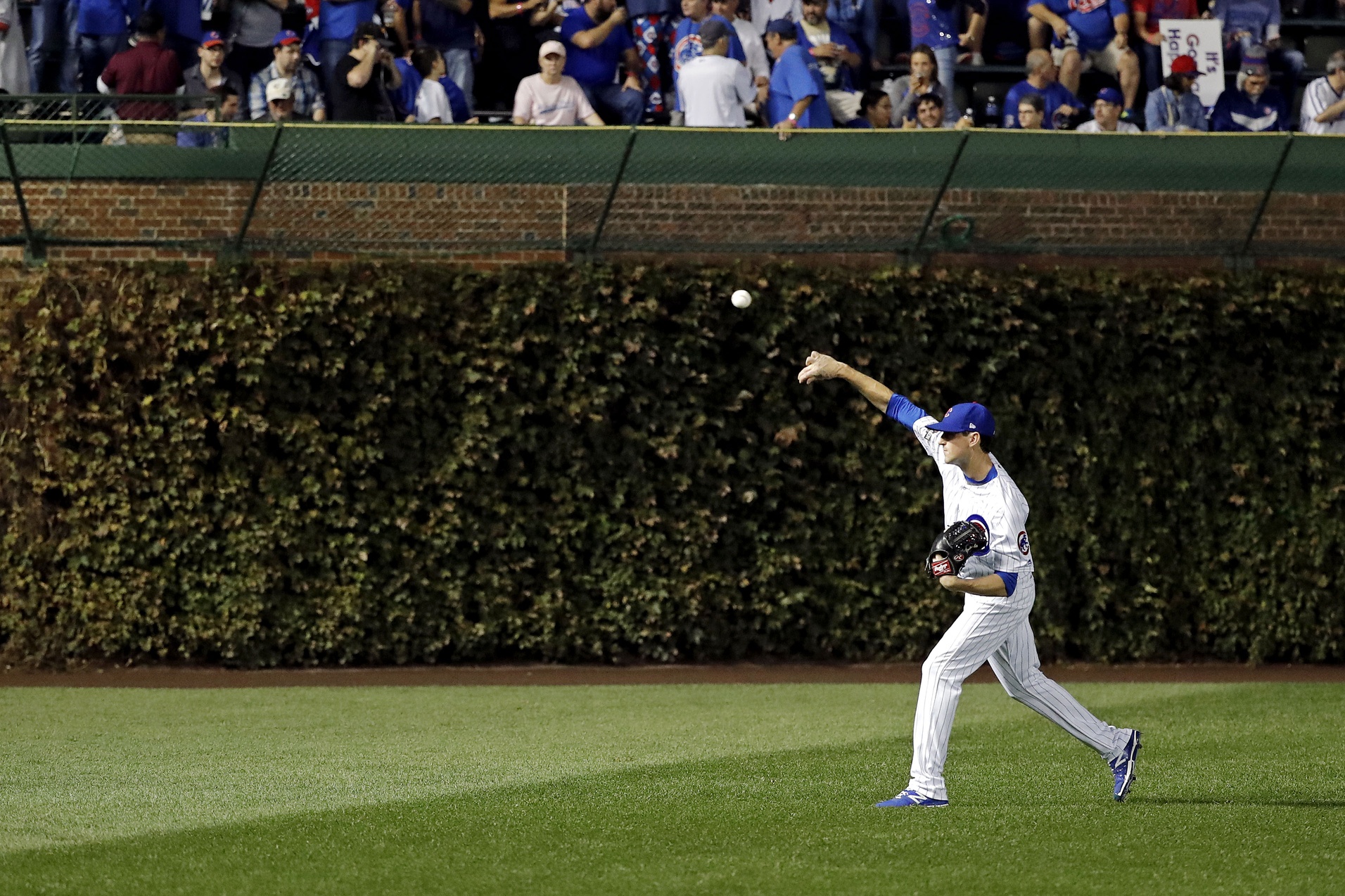How to preview in 900-1,100 words what could be a game 71 years in the making? The key, as I see it, is to keep basic. You know what’s at stake. You know the history. You have no need to hear my patented witty, trenchant pop culture references. So, let’s keep it basic.
In the depths of Chavez Ravine two nights ago, the bats came back in a big way. After scoring zero runs in straight 21 innings, the Cubs offense put up 18 runs in 14 innings. What’s the key to keeping it rolling in Game Six? Well, right now, after a slightly impatient start, the Cubs are making the Dodgers pitchers work. In Games 1-3, Cubs batters averaged 3.78 pitches per plate appearance. In Games 4-5, they averaged 4.22 pitches plate appearance, about a half pitch more per plate appearance. Lengthy plate appearances against Clayton Kershaw are easier said than done, but it’s clear now if it wasn’t alreay a patient Cubs offense is a more productive Cubs offense. And if the Cubs can get into that overworked Dodgers middle relief (see What to Watch for), all the better.
The Cubs are one win from the World Series, and all that’s standing in their way is the greatest pitcher of his generation and a Dodgers offense that was one of the league’s best after the All Star break. I mean, what could be more nauseatingly, excruciatingly, feel-it-in-the-pit-of-your-stomach, go-to-the-sink-and-splash-water-on-your-face exciting? Let’s break it all down below.
Pitching Matchup: Kyle Hendricks vs. Clayton Kershaw
In Game Two, the Dodgers batters were exceedingly patient against Kyle Hendricks, swinging at just 4 of 23 first pitches, with just being put into play. They were not much more aggressive on the second pitch of at-bats, swinging at just 5 of 22 second pitches. Hendricks’s four walks set a new postseason high, and matched his highest total in any start in 2016.
Heading in to Game Six, however, Hendricks, while being careful not live over the plate early in counts, knows he should be able to get ahead. What Hendricks has to do, though, is be careful of getting too predictable. Last Sunday night, he threw fastballs for strikes on the first two pitches to all three first inning batters. Opening the second inning, Hendricks started Adrian Gonzalez with a fourseam fastball at the bottom of the strike zone, which he took for strike one. Hendricks and Wilson Contreras did not alter the pattern, and came with another fourseam fastball on the next pitch. Gonzalez appeared ready for it, and launched a home run for the game’s winning run.
Hendricks found his greatest success with the change, using his fastball to set it up and keeping Dodgers hitters off balance, and he picked up three of his five strikeouts without allowing a base runner. Hendricks has not lost consecutive starts since mid-May, and during this stretch, as Carrie Muskat notes, he owns a 0.97 WHIP and 1.83 ERA.
Clayton Kershaw needed just 82 pitches to get through seven innings in Game Two. Kershaw was not messing around on Sunday night, as he threw his fewest curves (six) in a game since his Opening Day start in Colorado. In fact, the not messing around extends to his entire postseason. Kershaw has jumped his overall fourseam fastball usage from 50 percent in the regular season to 60 percent in the playoffs, with his usage rate jumping to 71 percent against left handed batters. On the first pitch of at-bats, he’s going to the fastball 77 percent of the time. With two strikes, Kershaw is turning to the fastball 50 percent, up from 35 percent during the regular season. While Kershaw typically ups his fourseam usage in the postseason, it has been even more dramatic than it was from 2013-2015.
The prevailing narrative seems to be Kershaw is pitching for his postseason legacy on Saturday night. Considering he’s gone for broke with his go-t0 pitch to this point, don’t be surprised if he leans on it early and often in Game Six. He’s going for the throat this October, and the Cubs should be ready for it tonight.
What to Watch for
Both bullpens will be all on hands on deck, with the possible exeption of Pedro Baez for the Dodgers, and the Cubs relief corps should be slightly more rested and ready. In Games Three and Four combined, Cubs relievers tossed 113 pitches over 7.0 innings pitched. The Dodgers, meanwhile, needed 219 pitches to get through 10 2/3 innings. For the Cubs, Travis Wood and Hector Rondon threw just 23 and 18 pitches, respectively, in Los Angeles. Mike Montgomery was the most worked, tossing 47 pitches.
The Cubs made slight adjustments during the final two games in Los Angeles, but, as we discussed in the Game Four preview, they largely remained confident that their talented, proven hitters would regain their form, or at the very least, have the law of averages on their side. They avoided making some crazy, wholesale lineup changes, and were awarded for their patience. They wore down Julio Urias and Kenta Maeda, and then went to work on that Dodgers bullpen. Despite their return to form, do not be surprised if the Cubs offense attempts to steal a run early with some small ball tactics, trading outs for an early lead. They should jump at the chance to get up on Kershaw and keep the 41,000 frenzied fans behind them abuzz with excitement and nerves, as opposed to just nerves.
Whatever it takes to win one more game. Keep it basic.
Lead photo courtesy Jon Durr—USA Today Sports.

For me, it’s executing every offensive opportunity, whether given or generated, and perfect defense tonight. I’m feeling an outcome for the history books tonight.
**Bartender!**